Warehousemen and Clerks' Schools, Purley, Surrey
In December, 1853, at the George Hotel and Tap, on Aldermanbury, East London, a group of warehousemen and clerks from the local 'Manchester' wholesale textile warehouses met to discuss how the might help the widow and young family of one of their colleagues who had just died. Their ideas soon broadened within a week or two they had laid the foundations of a charity to set up a School for 'the children of deceased and necessitous warehousemen and commercial clerks'. They set about raising funds for the scheme. A year later, donations of more than £6,000 had been received from over a thousand subscribers, with contributions coming from companies involved in the wholesale textile trade as well as individuals.
Initially, the children being by assisted were placed at private boarding schools in Sydenham and Blackheath. However, in 1855, with former Prime Minister Lord John Russell (later Earl Russell) as its president, the charity decided to establish its own establishment. Accordingly, Hatcham Grove House — a mansion with extensive grounds on the south side of Queen's Road, New Cross — was leased for the purpose.
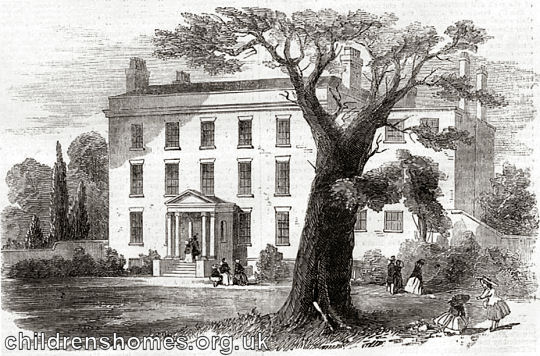
Warehousemen and Clerks' Schools, New Cross, c.1855.
Demand for places at the school steadily increased, with sixty in residence by 1861. In the short-term, admission became restricted to children whose fathers had been subscribers to the school. It was clear, however, that much larger premises were required and fund-raising for a new building was launched. Donations included the sum of £2,500 raised from a Grand Bazaar held at the Crystal Palace.
The new Warehousemen and Clerks' Schools were erected on a 20-acre hilltop site on what is now Russell Hill Road, Purley — historically located in the parish of Beddington. (The hill on which the Schools stood subsequently acquired the name Russell Hill in honour of the charity's president.) They buildings were designed in a Venetian Gothic style by John George Bland of Birmingham, and the grounds were laid out by Sir Joseph Paxton. The foundation stone for the scheme was laid on July 11th 1863 by the Prince of Wales (later Edward VII). The Prince also opened the completed buildings on June 18th 1866, accompanied by the Prime Minister Earl Russell. Other guests at the ceremony included the Lord Mayor of London, the Bishop of Winchester, and the charity's Trustees and Governors. Music was provided by the band of the Grenadier Guards. The event also raised further funds for the institution, with the opportunity for ladies to place a purse of money on a table in front of the Prince and receive a royal bow in return. More than £5,500 was raised during the day.
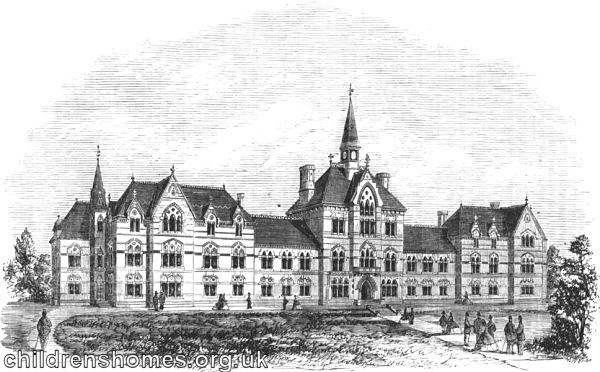
Warehousemen, Clerks and Drapers' Schools, Purley, c.1866. © Peter Higginbotham
Here is a contemporary report (slightly edited) on the new building:
This building is situated at Russell-hill, on a very elevated and healthy site, near the Caterham Junction, on the London and Brighton railway, to which it presents a frontage of about 280 ft.
The general effect of the building is striking and picturesque; the outline is much varied, with high-pitched roofs, dormers, and turrets. The materials used are red bricks, with blue and white brick strings, ornamentally disposed, and dressings of Bath stone. The roofs are covered with blue and green slates, in patterns. The front comprises a centre building, four stories in height, with a lofty hipped-roof, surmounted by a clock turret; buildings on either side of two stories, serve to connect the centre with the wings, which are of three stories. The principal entrance is in the centre, through a deeply-moulded and carved archway, with shafted jambs, to a hall divided by arches, carried on polished granite columns.
The interior faces of the walls of the hall are furnished with red and white bricks, in patterns; a staircase of stone, with pierced stone parapet, leads to the Visitors' Gallery. The dining-hall is entered from the hall, by folding doors, opposite the principal entrance, and is a fine room, 70 ft. long and 30 ft. wide, with an open timber roof of high-pitch, and lighted by a large traceried window, of five lights in the gable end, and two light windows in the bays of the sides. The hall communicates with the kitchen by a door and hatch. The right wing of the building is appropriated to the girls, and the left to the boys. In each case the ground floor is occupied by the school and class rooms, and the stories above by the dormitories. The two-story buildings between the centre and wings, contain the secretary's, matron's, assistant master's, waiting, and other rooms, on the ground floor.
The master's house is on the extreme left, and though communicating with the boys' corridors, is in every other respect a detached building. At the opposite end of the building is the mistress's room, in communication with the girls' schools, the matron's room being placed opposite a transverse corridor, leading to the kitchens, laundries, &c., the arrangement of the plan affords facility for the effectual supervision of each department by their respective heads. The kitchen buildings form two sides of a quadrangle, having the dining-hail and girls' wing on the other two sides, the space thus enclosed being occupied by a large swimming-bath, with glass roof. The whole of the building is heated by steam-pipes, in connexion with the boiler of a pumping-engine, on the basement floor.
Hot and cold baths are provided on each floor, in connexion with the respective dormitories, and the lavatories, water-closets, &c., have been arranged with great attention to convenience and cleanliness. Covered play-sheds are provided for the children of either sex.
The building, which stands in the centre of 20 acres of land, will accommodate nearly 200 children, about 135 boys, and sixty girls.
The layout of the Schools in around 1935 is shown on the map below.
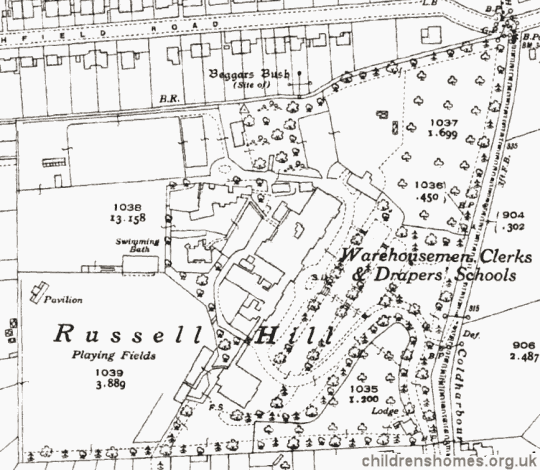
Warehousemen, Clerks and Drapers' School site, Purley, c.1935.
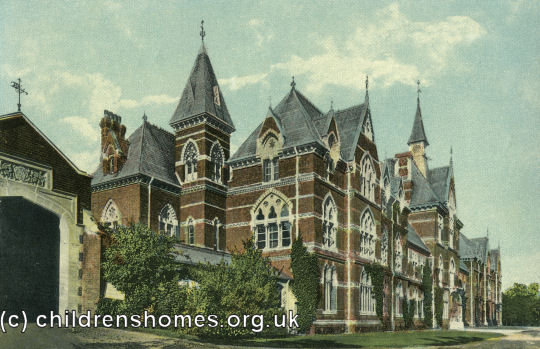
Warehousemen, Clerks and Drapers' Schools, Purley, c.1905. © Peter Higginbotham
In 1884, members of the drapery trade proposed the establishment of a Drapers' Orphanage, something which many viewed as a duplication of the Warehousemen and Clerks' activities. A merger of the two, although opposed by a meeting of the Warehousemen and Clerks' subscribers, was eventually agreed to by the Schools' Board. The institution then became known as the Warehousemen, Clerks and Drapers' Schools. From 1895, children of non-subscribers were again allowed admission with the number in the Schools reaching 320 by 1906.
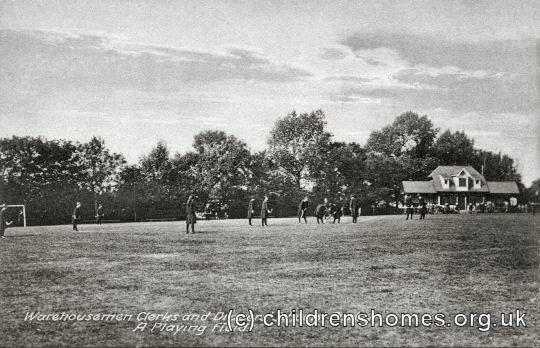
Playing field, Warehousemen, Clerks and Drapers' Schools, Purley, date unknown.
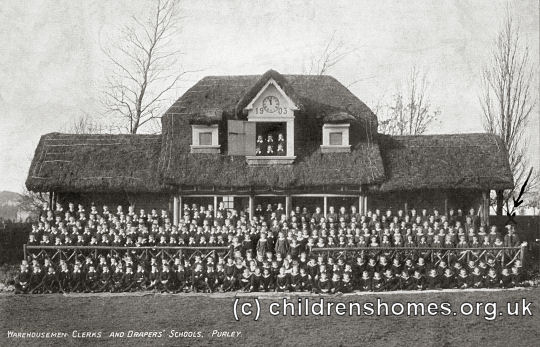
Warehousemen, Clerks and Drapers' Schools, Purley, c.1912. © Peter Higginbotham
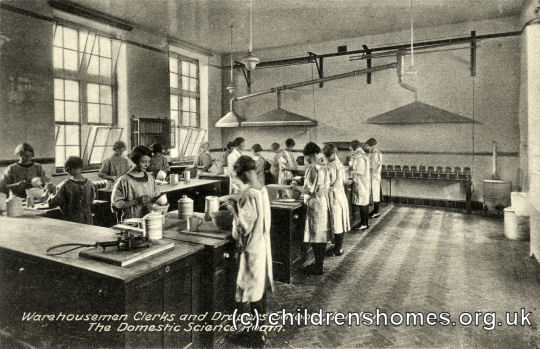
Domestic science room, Warehousemen, Clerks and Drapers' Schools, Purley, date unknown.
Soon after the Girl Guides movement was founded in 1910, the Schools established a Guides' Company.
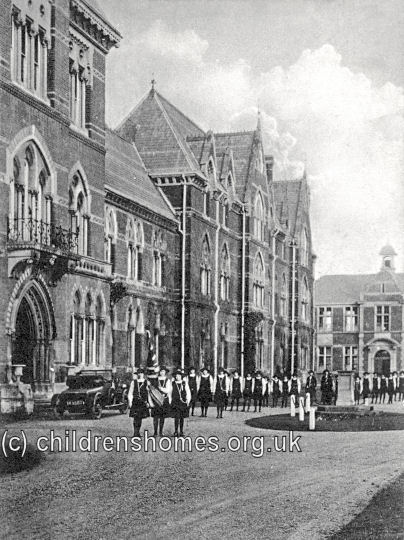
Warehousemen, Clerks and Drapers' Schools Guides, Purley, c.1911. © Peter Higginbotham
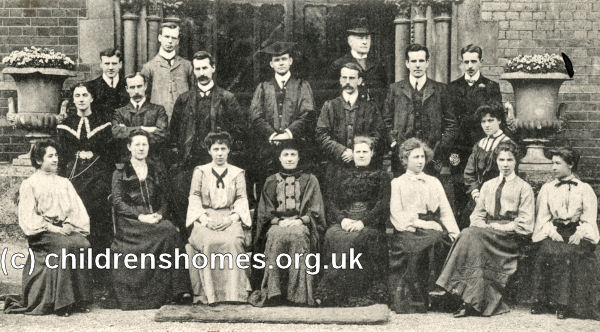
Warehousemen, Clerks and Drapers' Schools Staff, Purley, early 1900s. © Peter Higginbotham
A surge in demand from children orphaned in the First World War resulted in a need for increased accommodation. Instead of expanding the Purley premises, a second branch of the school — known as the Russell School — was established on the Ballards estate at Addington, near Croydon. The property, the former home of the politician Charles Goschen, was donated to the Schools' in 1920. It was decided that the girls should remain at Purley, while the boys were removed to Ballards.
Goschen's old house at Ballards was demolished and a new school erected in 1923-4. Designed by Sir Aston Webb (architect of the Admiralty Arch, the Victoria & Albert Museum, and the facade of Buckingham Palace), the new buildings comprised 3 blocks in a H-shaped layout. In 1924, the Prince of Wales laid the foundation stone for a chapel which was designed by Eric Gill and carved by his assistant Joseph Cribb. The school also had its own hospital block. The layout of the Ballards site is shown on the 1935 map below.
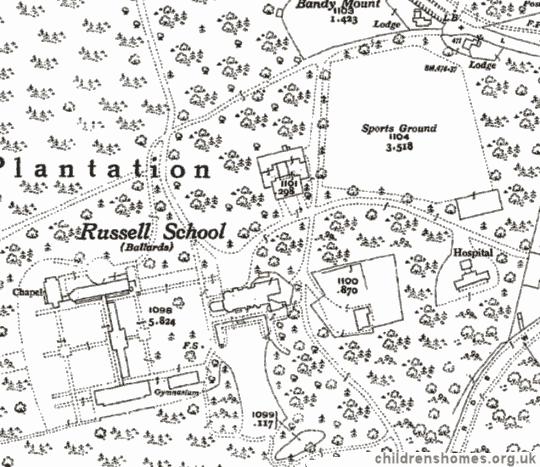
Russell School site, Addington, c.1935.
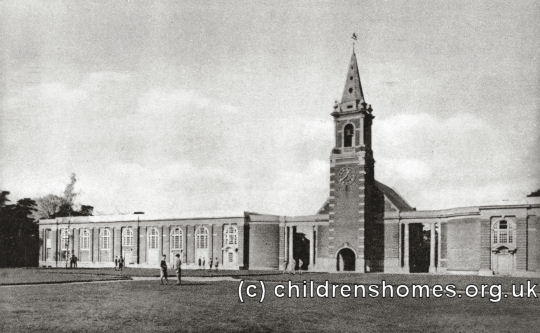
Assembly hall and chapel tower, Russell School, Addington, date unknown.
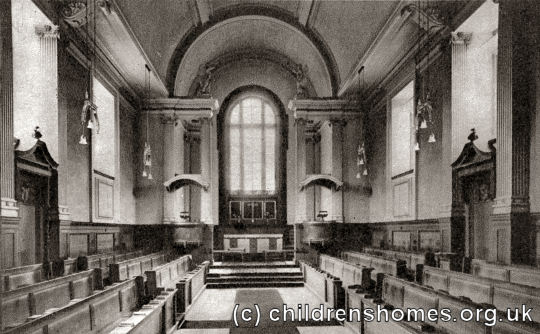
Chapel interior, Russell School, Addington, date unknown.
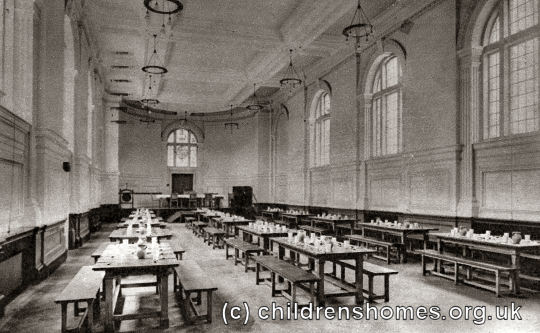
Dining-hall interior, Russell School, Addington, date unknown.
During World War Two, it was felt that the girls at Purley would be safer further from Croydon airport, so the boys and girls at the two sites switched locations.
The Russell School was renamed the Royal Russell School in 1953, the charity's centenary year.
In 1961, the Russell Hill School at Purley was closed and the children (girls and junior boys) transferred to Ballards where the accommodation was expanded accordingly. The Russell Hill site was sold to the Roman Catholic Diocese of Southwark and became home to the Thomas More Catholic School and Margaret Roper Catholic Primary School.
In 1968, the Royal Russell School became a fee-paying independent school, which it remains to this day, though no longer connected with the Drapers' Livery company.
The Schools' original home, Hatcham Grove House, was demolished in the late 1860s.
Records
Note: many repositories impose a closure period of up to 100 years for records identifying individuals. Before travelling a long distance, always check that the records you want to consult will be available.
- The National Archives, Kew, Richmond, Surrey, TW9 4DU. Holds a modest miscellany of material (1876-1956) including school inspection reports.
- The Royal Russell School has a substantial archive of material relating to the school, including complete admission registers dating back to the 1850s. A project to digitise this material is currently underway.
Census
Bibliography
- Hopewell, Stephen Royal Russell School, A History (1978, Hutchinson Benham)
Links
Except where indicated, this page () © Peter Higginbotham. Contents may not be reproduced without permission.


